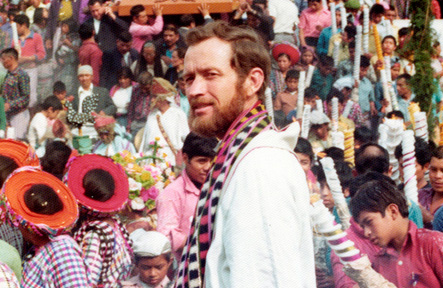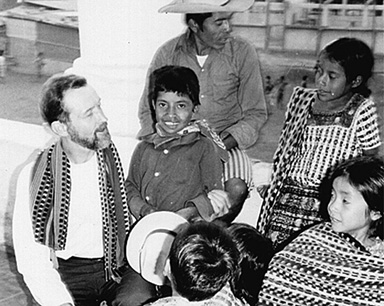
Padre Apla’s
Monday, December 4, 2017
*Rogelio Zelada
In the dampness of the night, the chirping crickets turned off their monotonous pitch and silence invaded the entire rectory of St. James. As if treading on air, a premonition of death and vileness, three masked hitmen searched for Padre Apla's, a missionary from Oklahoma. He, along with nine other priests, would be added to the list of victims of the civil war that bloodied the Guatemalan land, with hundreds of thousands of Catholics killed or missing.
Father Stanley Francis Rother came to mission land in Guatemala, in response to a request made by St. John XXIII to the American Church around 1960, for missionaries for Central and South America. By then, he was studying at Mount St. Mary’s Seminary, in Maryland.

Father Stanley Rother of Oklahoma, known to his Guatemalan people as Father Apla's, became the first martyr born in the U.S. He was killed July 28, 1981, one of 10 priests and thousands of Catholics who fell victim to that country's violent and bloody civil war.
Stanley Francis was born on March 27, 1935, in Okarche, Oklahoma, a small farming community of German origin. Stanley worked the fields on the family farm with his parents and siblings. He played sports and served as an altar boy at the parish church. He grew up in a healthy and peaceful environment where faith, church, family, a good education and shared hard work formed the character of the young man.
After finishing high school, he entered the seminary of Assumption, in San Antonio, Texas. There, he faced a big obstacle because he could not master Latin, a dead language that was a requirement at the time because texts and lessons employed it in all seminaries of the Catholic Church. An old teacher encouraged him to continue his priestly project and recalled the example of St. John Vianney, patron of priests, who had identical problems to access ordination.
His bishop encouraged him to seek a second chance at Mount St. Mary’s Seminary, in Maryland. Despite his academic difficulties, he finished his studies and was ordained on May 25, 1963.
The first Oklahoma missionaries sent by the Church arrived in 1964 at the indigenous community of Santiago Atitlán, which already had spent more than a century without the presence of priests in the area. It was a land where volcanoes and earthquakes abound, and where the Tz'utujil Maya grow coffee and corn amidst breathtaking scenery. The mission was marked by extreme hardship; their parishioners lived in very poor huts and sustained themselves with what they could grow in adjacent small plots.
Father Rother joined the team a few years after the establishment of the mission. When he arrived, he only knew about 10 words in Spanish, and although he could not understand Latin, he learned Spanish and dominated Tz'utujil to perfection, in order to communicate with the indigenous population. It was a very difficult language to learn, and he managed to translate to that Mayan tongue — which until then was not a written language — the entire New Testament, the Liturgy of the Eucharist, the Lectionary, and the Book of Prayers for the people. As “Stanley” was untranslatable into the local language, the natives decided to use his middle name, “Francisco,” which sounds like Apla's in Tz'utujil, and so they called him Padre Apla's or just Apla's.
Padre Apla's immediately connected with the people. He lived with simplicity and closeness, visited their huts and shared in their poverty. The tall man with a red beard and bright blue eyes, whose joy and enthusiasm were contagious, could share the tortillas offered to him sitting on the floor of a hut, drive a tractor, repair trucks or celebrate the Eucharist every Sunday in four different villages.

Father Stanley Rother of Oklahoma, seen here among his beloved Guatemalan people. During the bloody civil war there, he searched in roads and ditches for the bodies of those killed, to give them Christian burial. He was deemed suspicious also because he looked for food and assistance for widows and orphans of the dead and missing.
He made his parish flourish by tirelessly undertaking various projects. His friendly character and his joy, his willingness to share work and bread with his people, made the entire community see him as “our father.” His experience as an agricultural laborer in Oklahoma served him more than theology texts. He taught about new techniques and new crops, and designed useful irrigation systems. He established a farmers cooperative, built a school, a nutrition and food distribution center for the poor, a hospital and a clinic that currently serve more than 70,000 natives, and established the first Catholic radio station in the area to spread the catechetical work.
Dreadful times came to Santiago Atitlán. The civil war, which was covering Guatemala with violence, blood and suffering, extended its claws to the humble village. All of a sudden, peasant leaders, employees of the Catholic radio station, catechists and parishioners began to disappear, joining the list of the hundreds of thousands of murdered Catholics. The advocacy work for the indigenous, and the catechesis and education of poor peasants undertaken by Catholic missionaries, became suspicious and entangled in the conflict between guerrillas and the military.
Padre Apla’s appeared again and again on the list of those condemned to death. He was not looked upon kindly because he searched in roads and ditches for the bodies of those killed, to give them Christian burial; and because he looked for food and assistance for widows and orphans of the dead and missing.
On Christmas of 1980, the newspaper of the diocese published the last letter that Father Rother addressed to his parishioners: “The shepherd cannot run at the first sign of danger. Pray for us so that we can be signs of Christ's love for our people; may our presence give them strength so they can endure these sufferings in preparation for the Kingdom of God that is coming.”
Under great pressure and directly threatened with death, he was forced to leave Guatemala, but returned in April 1981 to his beloved Santiago Atitlán to celebrate Easter with his people.
On July 28, 1981, Father Stanley Francis Rother, “Padre Apla's,” was murdered in his room at the parish house. Two shots left him lying in a pool of blood that his assistant collected in a bottle “because it was of so much value that it should not be left on the floor.”
His body was returned to his native land, Oklahoma, but his heart remains in the parish church with the people that he served and loved so much. His room is a place of veneration and receives continuous visits. There remains the memory of the legacy of this priest who did not abandon his flock.
On December 2, 2016, Pope Francis officially recognized the martyrdom of Father Rother, and his solemn beatification was celebrated in Oklahoma City on September 23, 2017. He became the first martyr born in the United States, a simple man who made great things for the Kingdom of God out of an ordinary life. He was an illuminating witness of the extent where faith can reach if it is fully accepted under all circumstances, a priest and martyr for Guatemala and for the Church of the United States of America.


Comments from readers